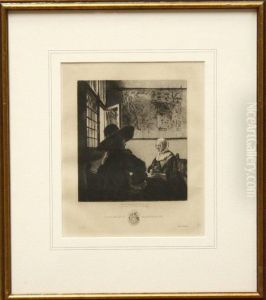Jules F. Jacquemart Paintings
Jules Ferdinand Jacquemart, a notable French printmaker and illustrator, was born on July 2, 1837, in Paris, France. He was renowned for his etchings that captured the subtle details of artworks and objects with exceptional finesse. Jacquemart's father, Albert Jacquemart, was an art lover and writer, which greatly influenced Jules's early exposure to the artistic world.
Jules Jacquemart developed his skills in the art of etching under the guidance of his father and was also influenced by the works of other prominent artists of the time. He began to gain recognition for his etchings that were not only precise but also imbued with an artistic sensitivity that went beyond mere reproduction. His works were particularly appreciated for their ability to convey the texture and materiality of the objects he chose to depict.
Throughout his career, Jacquemart worked on a variety of subjects, including portraits, landscapes, and still lifes, but he is especially remembered for his etchings of decorative arts, jewelry, and ceramics. His mastery in this genre was such that he was commissioned by the Louvre Museum to create etchings of the royal collection of Louis XIV, which further solidified his reputation.
Jules F. Jacquemart's contributions were also significant in the realm of book illustration. He collaborated with his father on the book 'Histoire de la Porcelaine' where his etchings brought the ceramics discussed to life. His work has been featured in various important publications, often accompanying texts with his visual interpretations.
Unfortunately, Jacquemart's life was cut short when he died on May 31, 1880, in Paris. Despite his relatively short career, Jacquemart left behind a legacy as one of the finest etchers of the 19th century, whose work continues to be studied and admired by art historians and printmaking enthusiasts alike.
